Municipalities across Door County are poised to spend more than $1 million in total to protect and repair public shoreline this year amid record-high water levels in Lake Michigan and Green Bay.
The projects involve public resources including roads, parks and marinas, and they range in size from removing brackets for a now-unnecessary dock to adding large stone, called riprap, to sections of shoreline stretching 2,000 feet or longer.
The work comes as a recently confirmed expense for municipalities, even though water levels have been on the rise in recent years. Marine contractor Mike Kahr, who is working with several municipalities across the county, said he was advising public officials as late as last year to wait and see how water levels would change over the fall and winter before determining what work was necessary.
Water levels usually decline significantly over the fall and winter before rising again in the spring and summer. That didn’t happen in the fall of 2019 or the early months of 2020.
Instead, lakes Michigan and Huron – which really are one giant body of water – saw less than half their usual decline over this past fall and winter, said Deanna Apps, a physical scientist with the U.S. Army Corps of Engineers Detroit District. That was due in part to a very wet fall and a warmer than usual early winter, Apps said.
That lack of decline has led to all-time high water levels so far in 2020. Levels in lakes Michigan and Huron have broken records – set in 1986 and 1987 – in every month so far this year.
The water level in the lakes currently is about 582 feet above sea level, more than six inches higher than it was at this time last year and about three feet above its long-term average, according to Army Corps of Engineers data.
The Army Corps of Engineers projects that the water will rise another several inches this year. Apps said she expects lake levels will continue to break records through July.
It’s difficult to attribute the rise in lake levels over the past few years to any one cause, Apps said, although wetter than usual weather over the past several years has been a factor.
Projects span entire county
Shoreline protection and repair projects this year are underway, already completed or being considered in municipalities throughout the county, from the town of Union to the town of Washington.
In Ephraim, among the areas where high water levels are the most visible, the village has undergone or is considering work in several places.
The village has spent about $10,000 so far to place sandbags around public buildings, including the village hall and the barn on Anderson Dock, and to raise a generator platform at a lift station and seal maintenance hole covers to the sanitary sewer system on Highway 42, said village administrator Brent Bristol.
Additionally, Bristol said, the village board approved $15,000 in spending on a study by Neenah-based McMahon Engineering to examine options for protecting the downtown area around the village hall from high water. Those options could range in price from a few thousand dollars to more than $500,000, Bristol said. They will be reviewed by the village’s physical facilities committee and the village board in the next month, Bristol said.
The village also is considering adding riprap to the north face of Anderson Dock, Kahr said.
Roads

Some of the biggest projects across the county involve roads at risk of flooding and erosion.
The Wisconsin Department of Transportation added riprap along the shoreline at the south end of Ephraim to protect Highway 42, said village president Mike McCutcheon, and a state engineer or supervisor is checking in weekly to see if more work is required.
“There is the threat – one, real high water where we lose 42 as a route,” McCutcheon said. “But two, erosion, where it would actually start to (destroy the road).”
McCutcheon said the state would make any decisions on highway closures.
In Baileys Harbor, officials are requesting funding assistance from the Army Corps of Engineers for construction along Frogtown Road, where erosion of the escarpment along Lake Michigan has undermined the road.
The project in total could cost between $1 million and $1.5 million, said Steve Parent of Baudhuin Surveying and Engineering, the town’s engineer. The town would cover 35 percent of the costs up to $1.5 million and all costs in excess of $1.5 million. The project would only proceed if the town’s request to the Army Corps of Engineers is approved, Parent said.
The town of Gardner is planning repairs and protective measures for a 2,100-foot stretch of North Stevenson Pier Road along Little Sturgeon Bay. The road is directly in the path of north winds and is getting washed out from underneath, said town chair Mark Stevenson.
The town plans to add riprap to a lot of the shoreline along the road, Stevenson said, and the project will cost about $225,000. The town has applied for and been approved for a state grant through the Door County emergency management department that will reimburse the town 70 percent of that cost, Stevenson said.
In the town of Union, work already is underway on a similar project along Bayshore Road, said town chair Brian Renard. The road, which runs along Green Bay, has been undermined in three places after storms last fall, Renard said. The project will cost about $150,000, Renard said, and the town is applying for a similar state grant that would reimburse the town 70 percent of the cost.
Parks
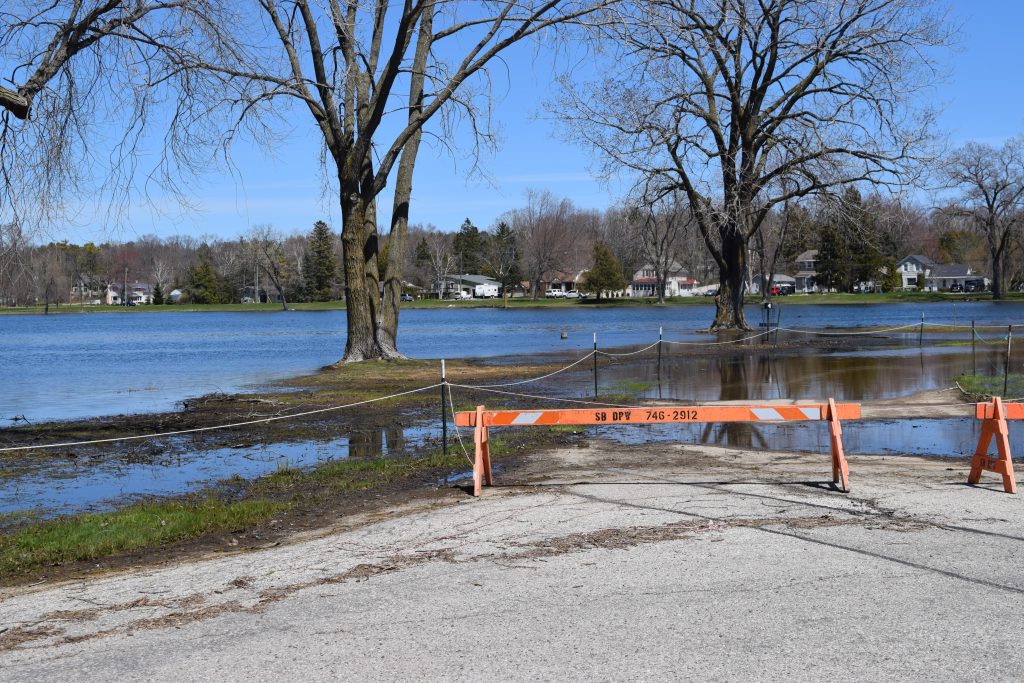
Significant work also has been done or is planned at municipal parks.
In Sturgeon Bay, the city is planning to spend about $650,000 in total on work at Sunset Park, Otumba Park and the railroad spur in Bay View Park near Sonny’s Pizza, said city administrator Josh VanLieshout.
At Sunset Park, there are some areas where 10 feet of the lawn has eroded since last year, said Mike Barker, the city’s municipal services director. The park was hit hard by storms last November and December, Barker said. The city is planning to use a combination of riprap and stepped stone revetment to protect the shoreline in the park, Barker said. The work, which covers about 2,000 feet of shoreline, will cost about $600,000, said Parent, the engineer on the project.
At Otumba Park, which is hit hard by northwest winds, erosion has undermined the sidewalk running along the shoreline, Barker said. The city is working on an engineering plan for repairs, Barker said.
And on the railroad spur, the breakwall was eroding and needed repair, said Kahr, whose company, Death’s Door Marine, worked on the project. That work already has been completed at a cost of about $35,000, Kahr said.
In Baileys Harbor, Death’s Door Marine also completed work to rebuild the breakwall around the jetty at Anclam Park, which saw significant damage this past fall and winter. That work cost between $225,000 and $250,000.
On Washington Island, town officials decided to close the Jackson Harbor Maritime Museum this year after it flooded, said Jonathan Mann, the town of Washington’s public works director. The town plans to add riprap around the dock on which the museum sits, Mann said, and the cost of the project will be reasonable because the town already has enough stone in its stores to do the work.
“Depending on what the lake level does long-term, we’re going to have to start raising buildings out there, which would get quite pricey,” Mann said. “But for this year they just made the stand to close it down.”
Marinas

Several municipalities also are undergoing or considering work at public marinas.
In the village of Egg Harbor, where the current marina was built in 2010, the village board is debating whether to proceed with a construction project that would raise the sidewalk on the marina’s breakwall and use that new sidewalk as the foundation for a removable wave wall or parapet wall. The removable wall would protect the floating docks inside the marina from possible wave damage.
The project is estimated to cost between $1.212 million and $1.429 million, according to a proposal prepared by Madison-based Edgewater Resources, the village’s engineering firm.
The village board has not yet fully approved an engineering study that would determine how much of the breakwall would need the removable wall installed, said Bob Dickson, a village trustee and the chair of the village’s harbor committee. (Disclosure: Knock editor Andrew Phillips’s father, Denny Phillips, is a member of the village’s harbor committee.)
The engineering study would cost about $65,000, said village administrator Ryan Heise.
“If we would have built it higher, we wouldn’t be having this talk right now.”
Village of Egg Harbor trustee Bob Dickson
Current water levels leave some room for second-guessing village decision-making when the marina was originally built, Dickson said.
After an initial referendum to fund the marina narrowly failed, the village altered the design to lower the breakwall. Dickson said he remembers the height difference being about three feet.
“That was a conscious decision made by everybody against the best judgment of the engineers that were advising us on the project,” Dickson said. “Ten years later, it’s biting us in the butt.”
“If we would have built it higher, we wouldn’t be having this talk right now,” he added.
Farther north, the town of Gibraltar has approved spending about $70,000 to add removable concrete wave barriers to the town dock, said town chair Steve Sohns. The work will be done by Death’s Door Marine.
The town also is keeping an eye on possible flooding in Clark Park, adjacent to the town dock, Sohns said. But the town has limited options to address that, Sohns said, because any barriers it put up would force the water onto neighboring private properties, creating flooding there instead.
Kahr said he also is working on raising docks at the Ellison Bay marina, and the village of Sister Bay has given the green light to a project involving adding stone to its marina’s breakwall and raising docks there. Officials from Sister Bay and the town of Liberty Grove did not respond to requests for comment.
In Baileys Harbor, the town is planning a long-term repair to its marina’s launch ramp area that would include repair and replacement work on some sheet pilings, Parent said. The project would cost about $25,000 and work would take place over the 2020-2021 offseason.
In Sturgeon Bay, the city removed brackets for a dock at the Sawyer Park boat launch that would now be underwater, Barker said.
Sewer systems
A few municipalities also are monitoring or undergoing or planning work on sewer systems.
In addition to the lift station work in Ephraim, the town of Baileys Harbor plans to raise a lift station on Ridges Road for its sanitary sewer system at a cost of about $10,000, Parent said.
Sturgeon Bay Utilities is monitoring high water levels on Memorial Drive and a stretch of 3rd Avenue near Sunset Park to ensure that water does not get into maintenance holes for the sanitary sewer system there, said Cliff White, the utility’s operations manager. White said the utility has checked to make sure the gaskets on all those maintenance hole covers are in good condition.
Municipalities turn to reserve funds, debt, grants
Officials who provided cost estimates for their municipalities’ shoreline work said they were equipped to cover those costs through reserve funds or general obligation debt and, in some cases, with the help of grants or other outside funding.
In general, smaller projects will be paid for with reserve funds, while larger projects will be covered by general obligation debt and/or grants.
The town of Baileys Harbor plans to use a combination of grants and reserve funds to pay for the work at Anclam Park, town chair Doug Smith said.
On Frogtown Road, Smith said the short-term fixes the town has done so far have come out of its roads budget. The town is waiting for an answer from the Army Corps of Engineers to better determine what the long-term cost will be there, Smith said.
The towns of Gardner and Union also have used reserve funds to cover the costs of road work there, Stevenson and Renard said. And the town of Gibraltar will use reserve funds to pay for the wave barriers on its town dock, Sohns said.

The city of Sturgeon Bay will use general obligation debt to pay for the work at its parks, VanLieshout said, pending approval by the city council.
The city prefers to pay for the work that way for two reasons, VanLieshout said. First, he said, the projects are long-term improvements.
“We try to match the debt with the life expectancy of the asset,” VanLieshout said.
The other reason, he said, is more philosophical: If the projects are funded through debt, rather than reserve funds, they definitely will be paid for by people living in the city when the completed work is available as a benefit, rather than people whose taxes may have contributed to reserve funds but who have since moved away.
In Egg Harbor, the village will consider a variety of funding sources if the village board decides to proceed with the engineering study and construction, Heise said. Those could include grants, state loans and general obligation debt, he said.
One thing he’s considering, Heise said, is that the village might benefit long-term by combining the project with other capital improvement projects it has planned, in order to get a better interest rate with a single bond.
Obstacles to paying for projects
Officials said there are some hurdles to paying for the shoreline projects.
In Gardner, Stevenson said the fact that the town has to pay for the cost of the shoreline work up front, before getting reimbursed by the state, could slow down some town services.
“It’ll slow us down a little, because we’ve got to spend the money up front,” Stevenson said. “It might slow some of our services down, but it won’t hinder them.”
In Sturgeon Bay, VanLieshout said his recommendation to the city council will be to proceed with the shoreline work at Sunset Park this year and delay dredging the city had planned for Bradley Lake (also known as Little Lake) inside the park. That’s for two reasons, VanLieshout said, with the first being urgency.
“Little Lake has been in the condition it’s in for some time,” he said. “But if we don’t do something with the erosion, we might not have much of Sunset Park left.”
The second reason, VanLieshout said, is that the lower cost of the shoreline work – about $600,000, compared to about $1 million for the dredging work – will help the city cover the costs of the coronavirus pandemic.
The costs of the pandemic for the city have included increased expenses as well as lost revenue.
“If we don’t do something with the erosion, we might not have much of Sunset Park left.”
City of Sturgeon Bay administrator Josh VanLieshout
The city now projects it will spend $75,000 this year on administering elections, an increase from its budgeted $27,000 due in part to the shift to mostly absentee voting, VanLieshout said. The Sturgeon Bay fire department also has had increased expenses because it has shifted to paying full-time firefighters overtime to cover for other full-time firefighters’ time off – rather than allowing part-time firefighters to fill in – in an effort to limit in-person contact, VanLieshout said.
In terms of revenue, the city projects that it will lose about $30,000 – 15 percent – of its usual $200,000 in annual room tax revenue, VanLieshout said.
“Those costs are difficult to quantify, because they tend to have to be based on forward-looking information that we just don’t have,” he said.
Heise said the village of Egg Harbor is in decent shape in terms of the financial impact of the coronavirus, because most of its room tax revenue funds events that now may not happen due to the pandemic.
But he said the pandemic and its economic effects have contributed to a caution among the village board toward spending.
“With everything else the world has going on – with COVID, and a recession if not a depression – they’re sensitive (to spending public money),” Heise said.
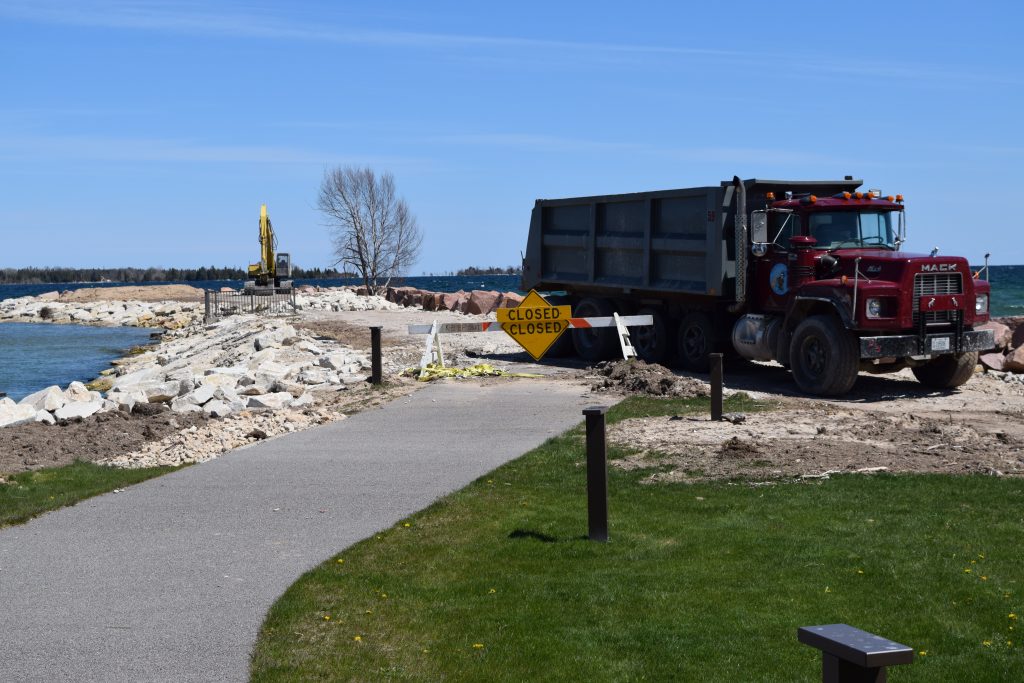
Reluctance to spend public money
That reluctance was shared by officials in a few municipalities, who said they prefer to take a wait-and-see approach to water levels this year.
“Ultimately, let’s say the water goes down,” said McCutcheon, the Ephraim village president. “It’s like, why fix the roof if it’s not raining?”
Having said that, McCutcheon said he’s confident in the village’s approach for this year.
“I would say with confidence that we are prepared for the highest estimate of what the water would get to this summer,” he said, noting that there could be times when the water will be higher than that due to wind.
Sohns of the town of Gibraltar expressed similar caution about spending too much.
“We don’t want to get carried away and do something (we’ll regret),” he said. Sohns noted that not many years ago, Gibraltar officials were talking about moving a dock because of low water levels.
“Ultimately, let’s say the water goes down. It’s like, why fix the roof if it’s not raining?”
Village of Ephraim president Mike McCutcheon
In Egg Harbor, Dickson argued the village should hedge its bets by going forward with the engineering study now, so that it can be better prepared if and when waters rise enough to make the sidewalk and removable wall construction necessary.
“I suppose we could all sit back and wait and cross our fingers,” he said. “My position is, let’s do the study and have that in our back pocket.”
The village should protect its asset, Dickson said.
“The risk is, then we do nothing, and we have a storm event, and we have damage to the docks,” he said, as well as possibly boats.
Municipalities have some time, at least in terms of wind-driven problems, Kahr said, because winds usually die down during the summer.
But he said he’s been urging officials to get construction done before the fall storm season, if they’re going to do it this year.
Kahr said he hopes municipalities will do shoreline protection work the right way, and not cut corners.
“You don’t screw around with Mother Nature,” Kahr said. “It’s a great equalizer. One storm, and you can tell if (the work is) going to last or not.”

North Stevenson Pier Road in the town of Gardner on Saturday, May 9, 2020. Photo by Solomon Lindenberg. 
Sunset Park in the city of Sturgeon Bay on Saturday, May 9, 2020. Roads and sidewalks at the park have been closed due to flooding. Photo by Solomon Lindenberg. 
The breakwall at the village of Egg Harbor marina on Saturday, May 9, 2020. Photo by Solomon Lindenberg. 
Sandbags envelop the lakeside perimeter of the village hall in Ephraim on Saturday, May 9, 2020. Photo by Solomon Lindenberg. 
Work continues on repairing the jetty at Anclam Park in Baileys Harbor on Saturday, May 9, 2020. Photo by Solomon Lindenberg. 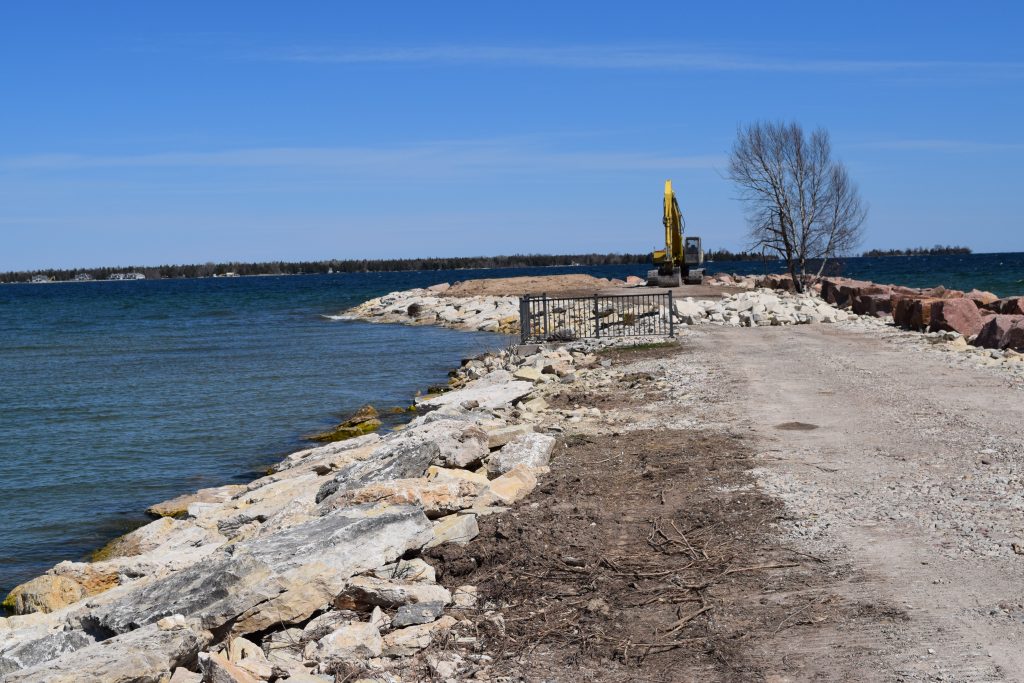
Work continues on repairing the jetty at Anclam Park in Baileys Harbor on Saturday, May 9, 2020. Photo by Solomon Lindenberg. 
The historic Anderson Dock in Ephraim on Monday, May 18, 2020. Photo by Solomon Lindenberg. 
The launch ramp area at the town of Baileys Harbor marina on Saturday, May 9, 2020. Photo by Solomon Lindenberg. 
The breakwall at the village of Egg Harbor marina on Saturday, May 9, 2020. Photo by Solomon Lindenberg. 
The launch ramp area at the village of Egg Harbor marina. Photo by Solomon Lindenberg. 
The Ellison Bay marina on Saturday, May 9, 2020. Photo by Solomon Lindenberg. 
The launch ramp area of the Ellison Bay marina on Saturday, May 9, 2020. Photo by Solomon Lindenberg. 
The Ellison Bay marina on Saturday, May 9, 2020. Photo by Solomon Lindenberg. 
The Ellison Bay marina on Saturday, May 9, 2020. Photo by Solomon Lindenberg. 
The village of Ephraim marina on Saturday, May 9, 2020. Photo by Solomon Lindenberg. 
The launch ramp area of the village of Ephraim marina on Saturday, May 9, 2020. Photo by Solomon Lindenberg. 
Sandbags have been stacked to protect buildings near the shore in Ephraim on Saturday, May 9, 2020. Photo by Solomon Lindenberg. 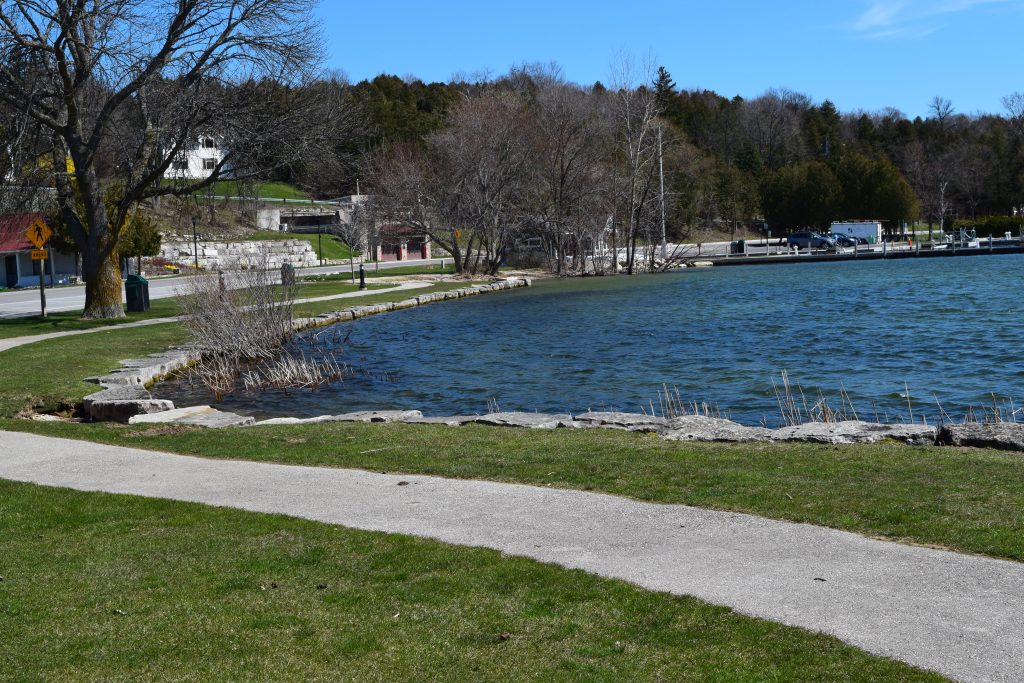
The shoreline in Ephraim on Saturday, May 9, 2020. Photo by Solomon Lindenberg. 
Lake levels near the crest of South Shore Pier in Ephraim on Saturday, May 9, 2020. Photo by Solomon Lindenberg. 
The shoreline in Ephraim on Saturday, May 9, 2020. Photo by Solomon Lindenberg. 
Sidewalks and docks near the water in Ephraim, seen here on Saturday, May 9, 2020, have been closed. Photo by Solomon Lindenberg. 
Sandbags envelop the lakeside perimeter of the village hall in Ephraim on Saturday, May 9, 2020. Photo by Solomon Lindenberg. 
Sunset Park in the city of Sturgeon Bay on Saturday, May 9, 2020. Roads and sidewalks at the park have been closed due to flooding. Photo by Solomon Lindenberg. 
Sunset Park in the city of Sturgeon Bay on Saturday, May 9, 2020. Roads and sidewalks at the park have been closed due to flooding. Photo by Solomon Lindenberg. 
Sunset Park in the city of Sturgeon Bay on Saturday, May 9, 2020. Roads and sidewalks at the park have been closed due to flooding. Photo by Solomon Lindenberg. 
Sunset Park in the city of Sturgeon Bay on Saturday, May 9, 2020. Photo by Solomon Lindenberg. 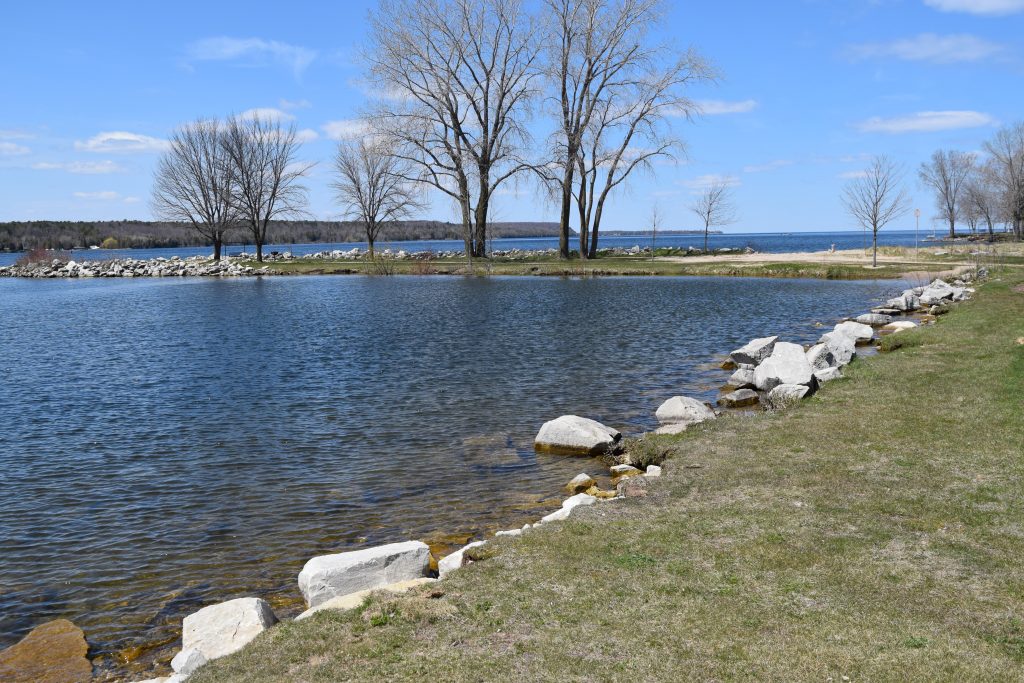
Sunset Park in the city of Sturgeon Bay on Saturday, May 9, 2020. Photo by Solomon Lindenberg. 
Sunset Park in the city of Sturgeon Bay on Saturday, May 9, 2020. Photo by Solomon Lindenberg. 
The dock at the Sister Bay beach on Monday, May 18, 2020. Photo by Solomon Lindenberg. 
The dock at the Sister Bay beach on Monday, May 18, 2020. Photo by Solomon Lindenberg. 
The dock at the Sister Bay beach on Monday, May 18, 2020. Photo by Solomon Lindenberg. 
The dock at the Sister Bay beach on Monday, May 18, 2020. Photo by Solomon Lindenberg. 
The Sister Bay beach on Monday, May 18, 2020. Photo by Solomon Lindenberg. 
North Stevenson Pier Road in the town of Gardner on Saturday, May 9, 2020. Photo by Solomon Lindenberg. 
North Stevenson Pier Road in the town of Gardner on Saturday, May 9, 2020. Photo by Solomon Lindenberg. 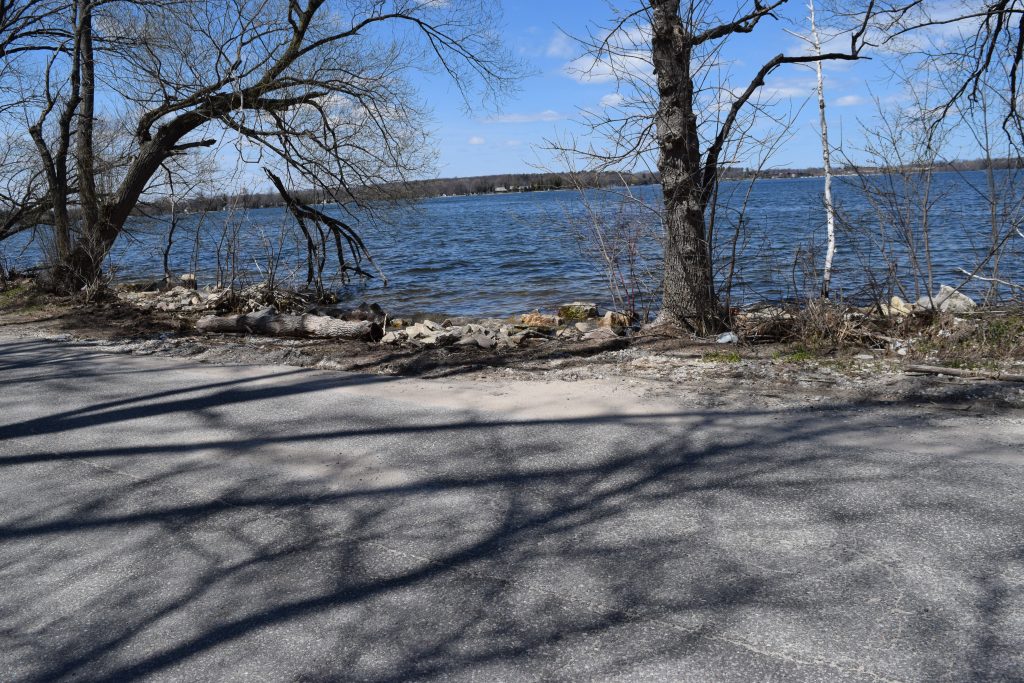
North Stevenson Pier Road in the town of Gardner on Saturday, May 9, 2020. Photo by Solomon Lindenberg. 
North Stevenson Pier Road in the town of Gardner on Saturday, May 9, 2020. Photo by Solomon Lindenberg. 
North Stevenson Pier Road in the town of Gardner on Saturday, May 9, 2020. Photo by Solomon Lindenberg. 
North Stevenson Pier Road in the town of Gardner on Saturday, May 9, 2020. Photo by Solomon Lindenberg. 
Sidewalks and docks near the water in Ephraim, seen here on Saturday, May 9, 2020, have been closed. Photo by Solomon Lindenberg. 
Sandbags envelop the lakeside perimeter of the village hall in Ephraim on Saturday, May 9, 2020. Photo by Solomon Lindenberg.
